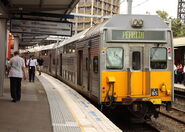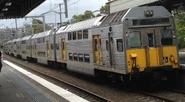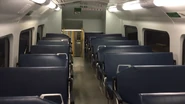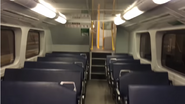m (Removed last revenue service on T7 as they can and have continued to run on the T7 when required) Tag: Visual edit |
No edit summary Tag: Visual edit |
||
| Line 6: | Line 6: | ||
== History == |
== History == |
||
| + | Originally, under contract 5/79, 8 cars (C3501-3504/D4096-4099, now all in K98/99) were ordered. This order was extended under contract 5/79E, with 90 more cars (C3505-3550/T4171-4216) arriving between December 1981 and July 1983. A further 30 cars (C3551-3580/T4217-4246) were ordered as part of contract 6/82, arriving between April 1984 and December 1985.[https://www.trainman.id.au/Electric_Data/K_Set_Cars.htm] |
||
| − | Originally, only the first four motor cars and driving trailers werent fitted with air conditioning. Later two more cars (C3550 and T4216) were also fitted with air conditioning to provide "spare" cars for the "air conditioned suburban train". All remaining "K" set cars were force ventilated until the late 1980s when the second batch (C3551/T4217–C3580/T4246) was fitted with air conditioning, this included the replacement of the "beclawat" windows with sealed non opening windows. |
||
| − | + | Originally, only the 8 cars in the first order were fitted with air conditioning. All others were built with forced air ventilation, with the exception of two cars (C3550 and T4216) in the first order extension that were fitted with air conditioning as spares for the other air conditioned cars. The second batch was retrofitted with air conditioning starting from 1988, however the first batch was not retrofitted until just prior to the Sydney 2000 Olympics. These cars retained the "hopper" windows from the "Citydecker" refurbishment until the late 2000s, but they were sealed shut with an adhesive to avoid the loss of air conditioning. The vents on the doors were also boarded up. |
|
In the early 2000s, traction interlocking and vigilance control were added to the K sets. For some time, K sets with these features fitted had a plus on the target plate, to mark that they were modified from the original design. The pluses have now been removed since it is not necessary to mark changes that the entire fleet has received. |
In the early 2000s, traction interlocking and vigilance control were added to the K sets. For some time, K sets with these features fitted had a plus on the target plate, to mark that they were modified from the original design. The pluses have now been removed since it is not necessary to mark changes that the entire fleet has received. |
||
| Line 21: | Line 21: | ||
== Description == |
== Description == |
||
| − | Like the [[Sydney Trains S Set|L, R & S sets]], the K set is a stainless steel double deck train. Each car is equipped with [http://obts.wikia.com/Railcar_Couplers#AARx_Couplers |
+ | Like the [[Sydney Trains S Set|L, R & S sets]], the K set is a stainless steel double deck train. Each car is equipped with [http://obts.wikia.com/Railcar_Couplers#AARx_Couplers knuckle couplers] and has a maximum speed of 115 km/h. Each set is in a C-T-T-C configuration (where C = Control motor, T = Non-control trailer), with the exception of the former K1-4, which were in a C-D configuration (where D = Driving trailer). The sets are currently numbered K60-99. |
| − | Each motor car has 4 four-phase Mitsubishi 150 kW motors (as per R and S Sets). The motor power is controlled by camshaft. The motors are powered by 1500V DC |
+ | Each motor car has 4 four-phase Mitsubishi 150 kW motors (as per R and S Sets). The motor power is controlled by camshaft. The motors are powered by 1500V DC from the overhead wires, while the lights and air-conditioning are powered by AC power from an alternator. There is one alternator for each C-T or C-D car pair. The K sets normally use EP braking and also have Westinghouse braking as a backup. |
The K set introduced many new features to the suburban fleet such as air conditioning and headlights. To accommodate the air conditioning and associated equipment, the pantograph had to be shifted to the adjacent trailer car to which the motor car is semi-permanently coupled and high voltage cables ran between the two cars. |
The K set introduced many new features to the suburban fleet such as air conditioning and headlights. To accommodate the air conditioning and associated equipment, the pantograph had to be shifted to the adjacent trailer car to which the motor car is semi-permanently coupled and high voltage cables ran between the two cars. |
||
| Line 36: | Line 36: | ||
Prior to the introduction of the Outer-Suburban [[Sydney Trains T Set|Tangara]] "G" sets, some of the "K" sets from the second batch were used on the [[South Coast line|South Coast]] and [[Central Coast and Newcastle line|Central Coast line]] (via North Shore) peak hour services and these carriages were fitted with high back headrest seats. |
Prior to the introduction of the Outer-Suburban [[Sydney Trains T Set|Tangara]] "G" sets, some of the "K" sets from the second batch were used on the [[South Coast line|South Coast]] and [[Central Coast and Newcastle line|Central Coast line]] (via North Shore) peak hour services and these carriages were fitted with high back headrest seats. |
||
| − | + | Between 1996-2013, the original order of 8 cars ran as four 2-car sets on local Newcastle services, running between Newcastle and Morisset. These cars returned to Hornsby for maintenance, which occured on a rotational basis. On such occasions, a four car K set was substituted on local Newcastle services. In special circumstances, two 2-car K sets were coupled together to form a 4-car set. |
|
Most K sets spent most of their life operating on Sector 3, which is made up of these lines: |
Most K sets spent most of their life operating on Sector 3, which is made up of these lines: |
||
| Line 55: | Line 55: | ||
=== Future === |
=== Future === |
||
The K sets will only run for a few more years until the [[NSW TrainLink D Set|NSW TrainLink D sets]] enter service (which will displace [[NSW TrainLink H Set|OSCAR]]s to suburban working). The exact timing is dependant on when these trains arrive and finish testing, however Sydney Trains is already making plans to dispose of these trains. |
The K sets will only run for a few more years until the [[NSW TrainLink D Set|NSW TrainLink D sets]] enter service (which will displace [[NSW TrainLink H Set|OSCAR]]s to suburban working). The exact timing is dependant on when these trains arrive and finish testing, however Sydney Trains is already making plans to dispose of these trains. |
||
| + | |||
| + | == Incidents == |
||
| + | |||
| + | * On 28 April 1984, a southbound K set (leading car C3550) crashed into the rear of a freight train just north of [[Cowan railway station|Cowan]].[https://trove.nla.gov.au/newspaper/article/125006792] |
||
| + | |||
== Trivia == |
== Trivia == |
||
* Similar to the other silver sets, if one pantograph momentarily loses contact with the overhead, the air-conditioning and lights (except emergency lights) will turn off. This is because there is no electrical connection between the car pairs, so each car is only connected to one pantograph. |
* Similar to the other silver sets, if one pantograph momentarily loses contact with the overhead, the air-conditioning and lights (except emergency lights) will turn off. This is because there is no electrical connection between the car pairs, so each car is only connected to one pantograph. |
||
Revision as of 10:20, 27 July 2021
The K set is a class of electric multiple unit operated by Sydney Trains and constructed by A Goninan & Co.
History
Originally, under contract 5/79, 8 cars (C3501-3504/D4096-4099, now all in K98/99) were ordered. This order was extended under contract 5/79E, with 90 more cars (C3505-3550/T4171-4216) arriving between December 1981 and July 1983. A further 30 cars (C3551-3580/T4217-4246) were ordered as part of contract 6/82, arriving between April 1984 and December 1985.[1]
Originally, only the 8 cars in the first order were fitted with air conditioning. All others were built with forced air ventilation, with the exception of two cars (C3550 and T4216) in the first order extension that were fitted with air conditioning as spares for the other air conditioned cars. The second batch was retrofitted with air conditioning starting from 1988, however the first batch was not retrofitted until just prior to the Sydney 2000 Olympics. These cars retained the "hopper" windows from the "Citydecker" refurbishment until the late 2000s, but they were sealed shut with an adhesive to avoid the loss of air conditioning. The vents on the doors were also boarded up.
In the early 2000s, traction interlocking and vigilance control were added to the K sets. For some time, K sets with these features fitted had a plus on the target plate, to mark that they were modified from the original design. The pluses have now been removed since it is not necessary to mark changes that the entire fleet has received.
K1-K4 were formed into four car sets K98 and K99 in February-March 2014, with the former K98 being renumbered K91. The driving trailers were partially converted to trailer cars, with the guard's compartment removed but the driver's compartment left.
In July 2017, asbestos was found in the circuit breaker panels, which is inside the driver compartment, of the C and K sets. This caused all C and K sets to be taken out of service for inspection. As a result, S sets were used to replace C/K sets temporarily on services that were scheduled as C/K. All K Sets have since returned to service.
In October 2017, all poles on K sets were painted yellow to comply with accessibility standards.
In August 2018, K96 was fitted with ATP (Automatic Train Protection) equipment. It has been tested extensively since.
Description
Like the L, R & S sets, the K set is a stainless steel double deck train. Each car is equipped with knuckle couplers and has a maximum speed of 115 km/h. Each set is in a C-T-T-C configuration (where C = Control motor, T = Non-control trailer), with the exception of the former K1-4, which were in a C-D configuration (where D = Driving trailer). The sets are currently numbered K60-99.
Each motor car has 4 four-phase Mitsubishi 150 kW motors (as per R and S Sets). The motor power is controlled by camshaft. The motors are powered by 1500V DC from the overhead wires, while the lights and air-conditioning are powered by AC power from an alternator. There is one alternator for each C-T or C-D car pair. The K sets normally use EP braking and also have Westinghouse braking as a backup.
The K set introduced many new features to the suburban fleet such as air conditioning and headlights. To accommodate the air conditioning and associated equipment, the pantograph had to be shifted to the adjacent trailer car to which the motor car is semi-permanently coupled and high voltage cables ran between the two cars.
There were two batches to the K set fleet. The first batch featured low mounted upper deck windows, brown interiors, and unpainted fronts. The second batch featured higher mounted upper deck windows, SRA "Candy" livery front, and yellow interiors, both of which have disappeared as a result of the "Citydecker" refubishment programme. The sets are fitted with reversible, single-sided seatback, vinyl covered seats.
As with the other silver sets, the K sets were built without destination boards, instead using four marker lights. All driving cars (except for the two D cars) were later retrofitted with flipdot destination boards, covering the top marker light.
Services
Historical
Prior to the introduction of the Outer-Suburban Tangara "G" sets, some of the "K" sets from the second batch were used on the South Coast and Central Coast line (via North Shore) peak hour services and these carriages were fitted with high back headrest seats.
Between 1996-2013, the original order of 8 cars ran as four 2-car sets on local Newcastle services, running between Newcastle and Morisset. These cars returned to Hornsby for maintenance, which occured on a rotational basis. On such occasions, a four car K set was substituted on local Newcastle services. In special circumstances, two 2-car K sets were coupled together to form a 4-car set.
Most K sets spent most of their life operating on Sector 3, which is made up of these lines:
The delivery of the A and B sets, starting in 2014, meant that many K sets were no longer required on Sector 3. The sets were gradually transferred to Sector 2, with all sets on Sector 2 by November 2017.
Prior to October 2020, they also operated the following, sometimes swapped with C sets:
Current
K sets currently run on Sector 2, comprising of:
 Leppington, Parramatta and Homebush to City Circle via Town Hall
Leppington, Parramatta and Homebush to City Circle via Town Hall Liverpool, Bankstown and Lidcombe to City Circle via Museum
Liverpool, Bankstown and Lidcombe to City Circle via Museum Macarthur, Campbelltown and Revesby to City Circle via Town Hall
Macarthur, Campbelltown and Revesby to City Circle via Town Hall
Future
The K sets will only run for a few more years until the NSW TrainLink D sets enter service (which will displace OSCARs to suburban working). The exact timing is dependant on when these trains arrive and finish testing, however Sydney Trains is already making plans to dispose of these trains.
Incidents
- On 28 April 1984, a southbound K set (leading car C3550) crashed into the rear of a freight train just north of Cowan.[2]
Trivia
- Similar to the other silver sets, if one pantograph momentarily loses contact with the overhead, the air-conditioning and lights (except emergency lights) will turn off. This is because there is no electrical connection between the car pairs, so each car is only connected to one pantograph.
- Like other silver sets, the K sets are fitted with a manual handbrake in the trailer car (seen in the fourth photo below).
- On 3 January 2020, set K74 held the honour of running the final K set roster for the Carlingford Line prior to its conversion for the Parramatta Light Rail.
- Sets K97 and K60 ran the last revenue service through platforms 1-2 at Sydenham before their closure on Christmas Day 2019 for Sydney Metro conversion.
- Car C3541 on set K74 has an incorrectly applied NSW TrainLink logo on the exterior.
External Links
Gallery
See also
List of Sydney Trains/NSW TrainLink fleets








